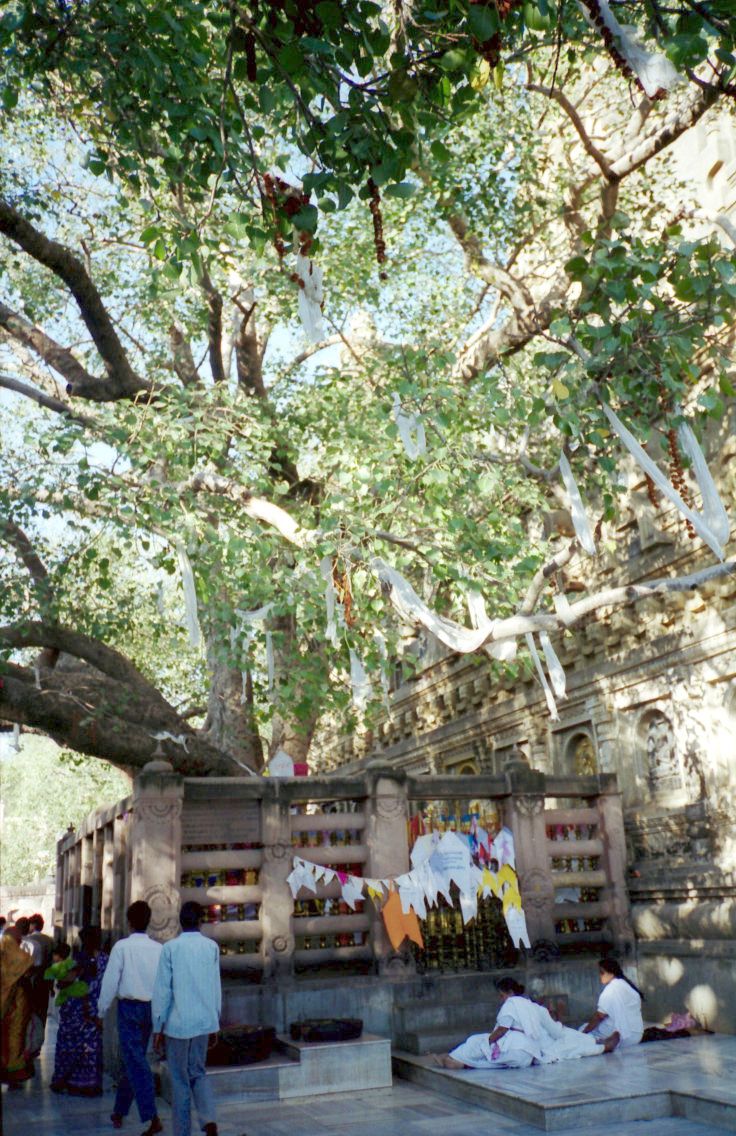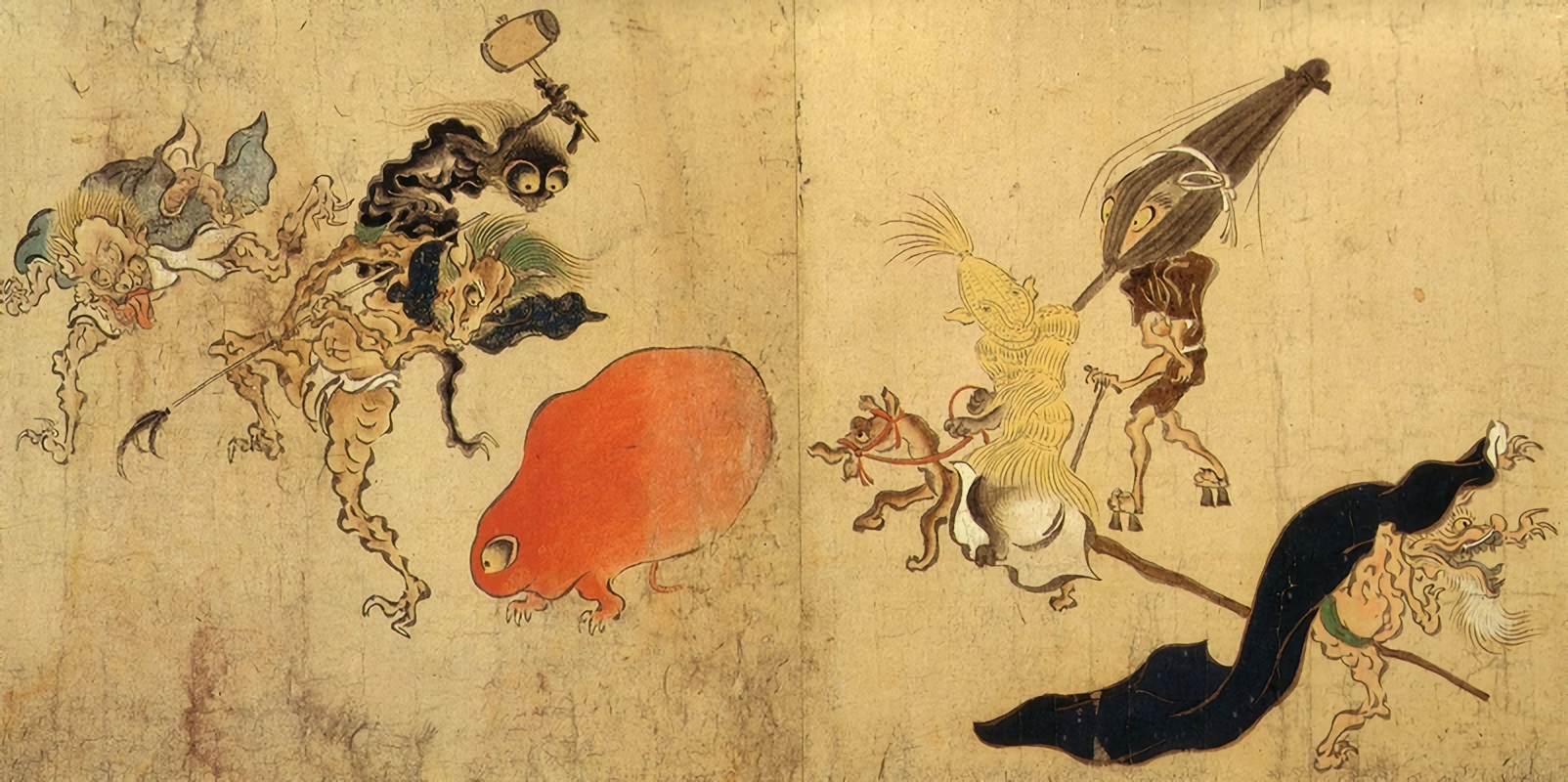|
Jubokko
The is a yōkai tree in Japanese folklore that appears in many books related to Japanese yōkai, including Shigeru Mizuki's works. According to folklore, it appears in former battlefields where many people have died, and its appearance does not differ that much from ordinary trees. Since it becomes a yōkai tree by sucking up large quantities of blood from the dead, it lives on human blood. When a human being happens to pass by, it supposedly captures the victim and, changing its branches into the shape of a tube, sucks the blood out of the victim. A Jubokko that sucks life out of human beings in such a way is said to always maintain a fresh appearance. When a Jubokko is cut, blood trickles out. It is said that a Jubokko branch could heal and decontaminate an injured person. Origin Folklore scholars such as Kunio Yanagita and Iwao Hino, who wrote works such as "Youkai Stories" and "Vocabulary of Changes in Japanese Youkai", respectively, state in written works about folklore yō ... [...More Info...] [...Related Items...] OR: [Wikipedia] [Google] [Baidu] |
Man-eating Plant
A man-eating plant is a fictional form of carnivorous plant large enough to kill and consume a human or other large animal. The notion of man-eating plants came about in the late 19th century, as the existence of real-life carnivorous and moving plants, described by Charles Darwin in '' Insectivorous Plants'' (1875), and ''The Power of Movement in Plants'' (1880), largely came as a shock to the general population, who believed it was impossible for plants to consume animals or move under their own power. Authors began to exaggerate these abilities for dramatic effect, causing the proliferation of fiction about such plants. The Madagascar tree The earliest known report of a man-eating plant originated as a literary fabrication written by journalist Edmund Spencer for the ''New York World''. Spencer's article first appeared in the daily edition of the ''New York World'' on 26 April 1874, and appeared again in the weekly edition of the newspaper two days later. In the article, a let ... [...More Info...] [...Related Items...] OR: [Wikipedia] [Google] [Baidu] |
List Of Legendary Creatures From Japan
The following is a list of Akuma (demons), Yūrei (ghosts), Yōkai (spirits), Kami and other legendary creatures that are notable in Japanese folklore and mythology. A B C D E F G H I J K A Kesaran Pasaran ... [...More Info...] [...Related Items...] OR: [Wikipedia] [Google] [Baidu] |
Yōkai
are a class of supernatural entities and Spirit (supernatural entity) , spirits in Japanese folklore. The kanji representation of the word comprises two characters that both mean "suspicious, doubtful", and while the Japanese name is simply the Japanese transliteration or pronunciation of the Chinese term ''yaoguai, yāoguài'' (which designates similarly strange creatures), some Japanese commentators argue that the word ''yōkai'' has taken on many different meanings in Japanese culture, including referring to a large number of uniquely Japanese creatures. are also referred to as , or . However, most Japanese generally think of the two loose classes of spirits as highly different, although some academics and Shinto practitioners acknowledge similarities within the seeming dichotomy between the natures of them and most ''kami'', which are generally regarded as relatively beneficent in comparison, and class the two as ultimately the same type of spirits of nature or of a m ... [...More Info...] [...Related Items...] OR: [Wikipedia] [Google] [Baidu] |
Shinchosha
is a publisher founded in 1896 in Japan and headquartered in , Shinjuku, Tokyo. Shinchosha is one of the sponsors of the Japan Fantasy Novel Award. Books * Haruki Murakami: '' Hard-Boiled Wonderland and the End of the World'' (1985), '' Uten Enten'' (1990), '' The Wind-Up Bird Chronicle'' (1997), '' After the quake'' (2000), '' 1Q84'' (2009–2010), '' The City and Its Uncertain Walls'' (2023) * Alex Kerr: '' Lost Japan'' (1993) Book series Magazines Weekly * – since 1956 * – manga, discontinued in 2010 * '' Focus'' – suspended Monthly * – Literary magazine since 1904 * * * '' nicola'' * (suspended) * * * * ''ENGINE'' – Automobile magazine, since 2000 * '' Foresight'' – Japanese edition discontinued in 2010 * - manga, since 2011 Web magazine * '' Foresight'' – Japanese edition since 2010 * ''Daily Shinchō'' – comprehensive news site basically excerpting from '' Shukan Shincho'' since 2015 Seasonal * ''Grave of the Fireflies'' In 1967, Shin ... [...More Info...] [...Related Items...] OR: [Wikipedia] [Google] [Baidu] |
Mythological Hematophages
Myth is a genre of folklore consisting primarily of narratives that play a fundamental role in a society. For scholars, this is very different from the vernacular usage of the term "myth" that refers to a belief that is not true. Instead, the veracity of a myth is not a defining criterion. Myths are often endorsed by religious (when they are closely linked to religion or spirituality) and secular authorities. Many societies group their myths, legends, and history together, considering myths and legends to be factual accounts of their remote past. In particular, creation myths take place in a primordial age when the world had not achieved its later form. Origin myths explain how a society's customs, institutions, and taboos were established and sanctified. National myths are narratives about a nation's past that symbolize the nation's values. There is a complex relationship between recital of myths and the enactment of rituals. Etymology The word "myth" comes from Ancient ... [...More Info...] [...Related Items...] OR: [Wikipedia] [Google] [Baidu] |
Trees In Mythology
Trees are significant in many of the world's mythologies, and have been given deep and sacred meanings throughout the ages. Human beings, observing the growth and death of trees, and the annual death and revival of their foliage, have often seen them as powerful symbols of growth, death and rebirth. Evergreen trees, which largely stay green throughout these cycles, are sometimes considered symbols of the eternal, immortality or fertility. The image of the Tree of life or world tree occurs in many mythologies. Examples include the banyan and the sacred fig (''Ficus religiosa'') in Hinduism, Buddhism and Jainism, the tree of the knowledge of good and evil of Judaism and Christianity. In folk religion and folklore, trees are often said to be the homes of tree spirits. Germanic mythology as well as Celtic polytheism both appear to have involved cultic practice in sacred groves, especially grove of oak. The term ''druid'' itself possibly derives from the Celtic word for oak. The Eg ... [...More Info...] [...Related Items...] OR: [Wikipedia] [Google] [Baidu] |
Yōkai
are a class of supernatural entities and Spirit (supernatural entity) , spirits in Japanese folklore. The kanji representation of the word comprises two characters that both mean "suspicious, doubtful", and while the Japanese name is simply the Japanese transliteration or pronunciation of the Chinese term ''yaoguai, yāoguài'' (which designates similarly strange creatures), some Japanese commentators argue that the word ''yōkai'' has taken on many different meanings in Japanese culture, including referring to a large number of uniquely Japanese creatures. are also referred to as , or . However, most Japanese generally think of the two loose classes of spirits as highly different, although some academics and Shinto practitioners acknowledge similarities within the seeming dichotomy between the natures of them and most ''kami'', which are generally regarded as relatively beneficent in comparison, and class the two as ultimately the same type of spirits of nature or of a m ... [...More Info...] [...Related Items...] OR: [Wikipedia] [Google] [Baidu] |
Shogakukan
is a Japanese publisher of comics, magazines, light novels, dictionaries, literature, non-fiction, home media, and other media in Japan. Shogakukan founded Shueisha, which also founded Hakusensha. These are three separate companies, but are together called the Hitotsubashi Group, one of the largest publishing groups in Japan and the world. Shogakukan is headquartered in the Shogakukan Building in Hitotsubashi, part of Kanda, Chiyoda, Tokyo, near the Jimbocho book district. The corporation also has the other two companies located in the same ward. International operations In the United States Shogakukan, along with Shueisha, owns Viz Media, which publishes manga from both companies in the United States. Shogakukan's licensing arm in North America was ShoPro Entertainment; it was merged into Viz Media in 2005. Shogakukan's production arm is Shogakukan-Shueisha Productions (previously Shogakukan Productions Co., Ltd.) In March 2010 it was announced that Shogakuka ... [...More Info...] [...Related Items...] OR: [Wikipedia] [Google] [Baidu] |
Murakami Kenji
{{disambiguation ...
Murakami may refer to: * 3295 Murakami, a minor planet * Murakami (crater), an impact crater on the far side of the Moon * Murakami (name), a Japanese surname, including a list of people with the name * Murakami, Niigata, a city in Niigata prefecture * Murakami Domain, a clan within Feudal Japan * "Murakami", a song by Russian rock singer Svetlana Surganova * "Murakami", a song on the 2015 album ''Without My Enemy What Would I Do'' by U.S. band Made In Heights See also * Murakami Station (other) Murakami Station is the name of multiple train stations in Japan. * Murakami Station (Chiba) is a passenger railway station in the city of Yachiyo, Chiba, Japan, operated by the third sector railway operator Tōyō Rapid Railway. Lines Murak ... [...More Info...] [...Related Items...] OR: [Wikipedia] [Google] [Baidu] |




